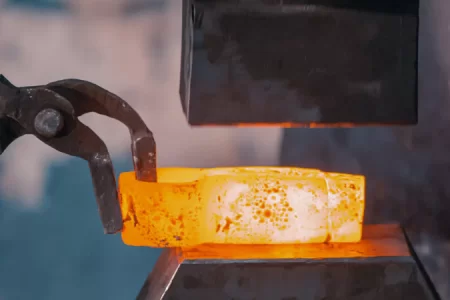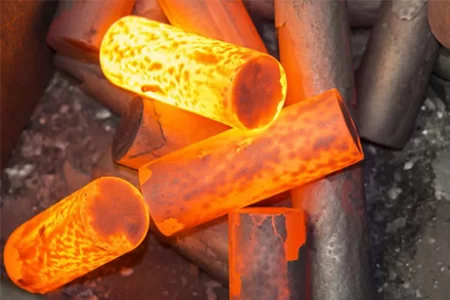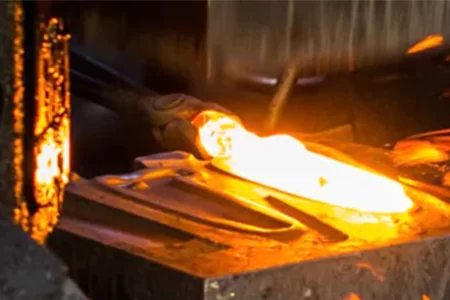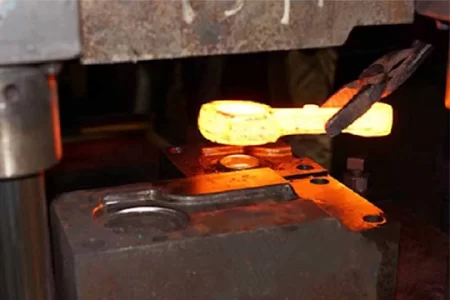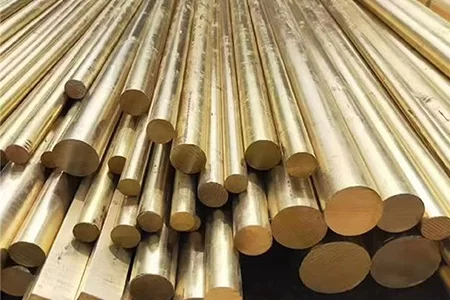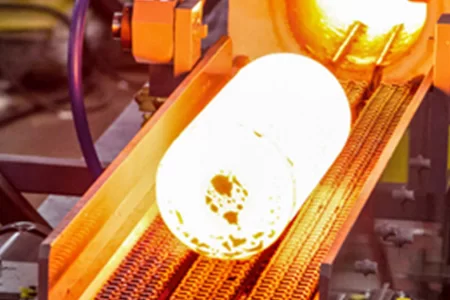By sharing knowledge, experience and views in the field of forging technology, we help you understand, learn and apply relevant technologies.

Hulk Metal Forging Technology
Share technical experience
-
Home>
-
Blog>
-
Technology>
Maintenance of forging dies: ensuring forging life and efficiency

Introduction
Forging is an important manufacturing process in metal processing and is widely used in industries such as mining, construction, energy, and machinery manufacturing. In the forging process, the die plays a vital role, which directly affects the quality of the product, production efficiency, and the service life of the die. Therefore, the maintenance of the forging die is particularly important. Good maintenance can not only extend the service life of the die but also ensure the efficiency and stability of forging production. This article will discuss the maintenance methods of forging dies and their impact on forging production, and provide some technologies and strategies for optimizing die maintenance and extending die life.
The basic composition of forging dies
Basic design principles of forging dies
The design of forging dies should have high strength, high wear resistance, and good thermal stability to adapt to extreme temperatures and high-pressure environments during the forging process. The design of the die needs to consider the rationality of the die structure, the improvement of processing efficiency, and the extension of the die life. In the early stage of design, it is necessary to clarify the working principle, material properties, and expected use environment of the die to ensure that the design scheme has sufficient durability.
The main components of forging die: die core, die base, cooling system
Forging dies are usually composed of several main components such as a die core, die base, and cooling system. The die core is responsible for forming the shape of the workpiece, the die base provides the necessary support and restraint force, and the cooling system is used to control the temperature of the die to ensure the normal operation of the die. The material selection, structural design, and surface treatment of the die core and die base directly affect the working effect and life of the die. The design of the cooling system must ensure that the die temperature is within a reasonable range to avoid damage to the die due to overheating or overcooling.
Material selection and application of forging dies
The selection of die materials is crucial to the performance of the die. Commonly used forging die materials include high-strength alloy steel, tool steel, and wear-resistant steel. These materials have high hardness and wear resistance and can maintain stable performance under high temperatures and high-pressure conditions. High-strength alloy steel is usually used for die parts that withstand greater impact and wear, while tool steel is widely used in precision molds, and wear-resistant steel is often used to manufacture die parts with more severe surface wear.
High-strength alloy steel
High-strength alloy steel has high fatigue resistance and impact resistance and is suitable for forging die parts that bear large loads. Through the optimization of heat treatment and surface treatment processes, its wear resistance and oxidation resistance can be further improved, thereby increasing the service life of the die.
Tool steel and wear-resistant steel
Tool steel is an important material for manufacturing precision molds. It has good hardness and wear resistance and is suitable for high-precision and high-surface quality forging processes. Wear-resistant steel has strong wear resistance and is often used for parts with frequent friction, which can significantly increase the service life of the mold.
The effect of heat treatment on mold material
The heat treatment process plays a vital role in the mold manufacturing process. Different heat treatment processes (such as quenching, tempering, quenching, and tempering, etc.) can significantly improve the hardness, toughness and wear resistance of the mold material. A reasonable heat treatment process can improve the performance of the mold and make it more adaptable to the high temperature and high-pressure environment during the forging process.
Working environment and use conditions of forging dies
Effect of high-temperature working environment on dies
Forging dies usually work in high-temperature environments, which makes the dies subject to great thermal stress and thermal expansion. Under high-temperature conditions, the hardness and wear resistance of the dies may be reduced, and even deformation and cracks may occur. Therefore, the material of the dies needs to have good thermal stability and be able to resist damage caused by high temperatures.
Effect of impact and wear
During the forging process, the dies will be impacted and rubbed by metal materials, resulting in surface wear and damage. Wear usually occurs on the surface where the dies contact the metal materials, and impact will cause cracks or breakage of the dies. Frequent impact and wear not only affect the accuracy of the dies, but may also cause quality problems of the workpiece. Therefore, keeping the surface smooth and wear-resistant of the dies is the key to maintenance.
Thermal expansion and cooling contraction of the dies during forging
Temperature changes during forging will cause thermal expansion and cooling contraction of the die materials, and long-term thermal cycles may cause deformation, cracks, or fatigue damage to the dies. Therefore, the design of the forging dies needs to consider the thermal expansion coefficient to avoid damage caused by excessive temperature differences. At the same time, a reasonable cooling system design can effectively alleviate this thermal expansion phenomenon.
The impact of forging load on the pressure of the die
During the forging process, the die is subjected to huge pressure and load. Especially under heavy load and high pressure, the die parts may be plastically deformed, cracked, or even broken. The material selection, design, and manufacturing process of the die need to ensure that it has sufficient bearing capacity and durability to cope with the pressure generated during the forging process.
Basic principles of die maintenance
Preventive maintenance and restorative maintenance
The maintenance of the die can be divided into two types: preventive maintenance and restorative maintenance. Preventive maintenance avoids problems with the die during use through regular inspections and necessary maintenance measures; restorative maintenance is to repair the die after failure or damage to restore the normal working state of the die. An effective maintenance strategy should combine the two to ensure the long-term stable operation of the die.
The criticality of regular inspection and periodic maintenance
Regular inspection and periodic maintenance are essential to ensure the efficient operation of the forging die. The inspection content includes the wear and tear of the die surface, cracks, heat treatment effect, working state of the cooling system, etc. Through regular maintenance, potential problems can be discovered and repaired in time to avoid large-scale damage.
Development and implementation of maintenance plan
The enterprise shall develop a detailed mold maintenance plan based on production needs and mold usage. The maintenance plan should include the inspection cycle, inspection content, repair and replacement cycle, etc., to ensure that the mold can be reasonably maintained and maintained at different working stages.
Training of operators and technicians
Professional training of operators and technicians is crucial to the effectiveness of mold maintenance. Regular technical training can improve the staff's awareness of mold maintenance, help them master the latest maintenance techniques and skills, and ensure smooth progress.
Maintenance technology of forging molds
Surface wear and fatigue analysis
The surface wear and fatigue of the mold are the main factors affecting the life of the mold. Through regular wear inspection and fatigue analysis, the use status of the mold can be judged and problems can be found in time. Wear usually causes the mold surface to be rough, affecting the surface quality of the workpiece; fatigue may cause the mold to break or fail.
Classification of damage modes
Damage modes include several types such as wear, cracks, and deformation. Different damage modes require different repair methods and techniques. For example, minor wear can be repaired by surface hardening or coating, while cracks or deformations require welding or mold replacement.
Damage prevention and repair technology
The technologies for preventing wear and fatigue mainly include mold surface coating, strengthening treatment, and reasonable cooling design. Repair technologies include welding repair, thermal spraying, laser cladding and other methods, which can effectively restore the surface performance and shape of the mold.
Cleaning and lubrication of molds
The cleaning and lubrication of molds play an important role in reducing wear and extending service life. Regularly cleaning the mold surface to remove oxide layers, deposits and dirt can help improve the wear resistance of the mold. Lubrication can reduce friction and improve the working efficiency of the mold.
Importance of cleaning and common cleaning methods
Mold cleaning includes removing impurities, clearing cooling channel blockages, and removing surface deposits. Common cleaning methods include mechanical cleaning, chemical cleaning and high-pressure water spraying. The choice of each method should be determined according to the material and degree of contamination of the mold. For example, chemical cleaning is suitable for removing oil and oxides, while high-pressure water spraying is suitable for removing more stubborn deposits. The key to the cleaning process is to avoid damage to the mold surface and keep it in good working condition.
Optimization and management of the lubrication system
Lubrication of molds is an effective means to reduce friction, reduce wear, and improve work efficiency. The selection of lubricating oil or lubricant should be customized according to the working environment, use conditions and material of the mold. Reasonable lubrication methods include regular addition of lubricating oil, optimization of lubricating oil flow and spraying method, and selection of appropriate lubricant types. Effective lubrication can not only reduce the friction between the mold and the metal but also play a cooling role in preventing the mold from overheating.
Repair technology of heat treatment and surface treatment
Heat treatment and surface treatment technology are important components of mold maintenance. Through reasonable heat treatment and surface hardening treatment, the wear resistance, impact resistance, and corrosion resistance of the mold can be significantly improved, thereby extending the service life of the mold.
Effect of heat treatment on mold life
Heat treatment includes quenching, tempering, quenching and tempering, and other processes. Through different process combinations, the performance of mold materials can be effectively improved. Appropriate heat treatment can improve the hardness and strength of the mold so that it can better withstand high temperature, high pressure, and impact load during forging. Different mold materials require the selection of appropriate heat treatment processes to ensure that the mold has the best working performance.
Surface hardening technology and application
Surface hardening technology significantly improves the wear resistance and fatigue resistance of the mold by forming a hardened layer on the mold surface. Common surface hardening technologies include carburizing, nitriding, laser cladding, etc. These technologies can effectively reduce mold surface wear, improve the mold's oxidation resistance and corrosion resistance, and thus extend the mold's service life.
Technology to prevent overheating and thermal shock
When the forging mold works in a high-temperature environment, it may cause thermal shock due to a sudden rise or drop in temperature, which in turn causes damage to the mold. Therefore, controlling the temperature of the mold and preventing overheating become important tasks for mold maintenance.
Design and management of the cooling system
Reasonable cooling system design can effectively prevent the mold from overheating, slow down the thermal expansion of the mold, and keep its temperature within a reasonable range. The design of the cooling system usually considers aspects such as the flow mode of the fluid, the selection of coolant, and the distribution of cooling channels. By optimizing the design of the cooling system, not only can the cooling effect of the mold be improved, but the risk of thermal shock can also be reduced.
Optimization methods for heat dissipation
In addition to the use of coolant, the heat dissipation performance of the mold itself is also very important. By adding heat sinks to the mold design and optimizing the thermal conductivity of the mold, the heat dissipation effect of the mold can be further improved to prevent the mold from overheating or deformation at high temperatures. Effective heat dissipation design can improve the working efficiency of the mold and extend its service life.
Mold failure analysis and repair
Common types of forging mold failures
During long-term use, forging molds may have different types of failures, which usually affect the performance, precision, and production efficiency of the mold.
Fatigue cracks and fractures
Fatigue cracks are a common form of damage to the mold, usually occurring in the high-stress area of the mold. After a long forging cycle, the mold material will produce microcracks due to repeated stress, which eventually leads to the fracture of the mold. In order to prevent fatigue cracks, the mold design needs to ensure uniform stress and use high-strength materials to increase fatigue resistance.
Surface damage and wear
Due to the high temperature and high pressure during the forging process, the mold surface is often prone to damage. The effect of friction may cause the mold surface to be worn, affecting the service life of the mold and the quality of the workpiece. Surface damage and wear usually need to be solved through regular inspection and repair.
Deformation caused by thermal shock
Thermal shock refers to the thermal stress caused by excessive temperature differences during the temperature change of the mold, which usually causes deformation or cracks in the mold. Excessive working temperature or rapid cooling of the mold will increase the risk of thermal shock.
Cause analysis of failure
The occurrence of mold failure is usually the result of multiple reasons, which may involve multiple links such as design, materials, processes or operations.
Effect of forging process on mold
An improper forging process will aggravate the wear and damage to the mold. For example, unreasonable mold design or improper temperature and pressure control during forging will have an adverse effect on the mold and cause it to fail prematurely. Therefore, optimizing the forging process and ensuring the stability of process parameters are the keys to reducing mold failures.
Unqualified materials and process deviations
Quality problems of mold materials or deviations in production processes may also lead to reduced mold performance and increase the probability of failure. For unqualified materials, the fatigue resistance, wear resistance and impact resistance of the mold may be insufficient, causing mold damage. Therefore, strictly controlling the quality of materials and optimizing the production process are the basis for ensuring mold reliability.
Improper operation and inadequate maintenance
Improper operation and inadequate maintenance by operators are also important causes of mold failure. The use of molds needs to follow strict operating specifications, and regular inspection and maintenance can timely detect potential fault hazards. If the operation is improper or the maintenance work is not in place, the damage to the mold will be accelerated.
Fault repair methods and technologies
According to different types of mold failures, the corresponding repair methods and technologies can effectively extend the service life of the mold.
Welding and repair welding technology
Welding and repair welding technology are common methods for repairing mold cracks and damage. For larger cracks and damage, welding can fill the defects of the mold and restore its shape and function. Repair welding technology can effectively solve local damage caused by improper operation or long-term use.
Laser cladding and arc spraying
Laser cladding and arc spraying are common surface repair technologies. Laser cladding technology can form a high-strength alloy layer on the mold surface, significantly improving the wear resistance of the mold; while arc spraying repairs the worn surface by spraying metal materials, reducing the wear rate and extending the life of the mold.
Low-temperature repair and stress relief
Low-temperature repair technology reduces thermal stress during mold repair by controlling the temperature change rate and uniformity and prevents new cracks from being generated due to excessive temperature differences. At the same time, stress relief treatment also helps to reduce the internal stress that may be generated in the mold during the repair process and ensures the performance of the repaired mold.
Strategies to improve the life of forging molds
Optimize the forging process and mold design
By optimizing the forging process and mold design, the service life of the mold can be significantly improved. For example, reasonably designing the shape and size of the mold, reducing local stress concentration, reasonably distributing the heat load of the mold, and avoiding excessive impact force can all help to improve the life of the mold.
Selection and application of advanced materials
Selecting advanced mold materials, such as high-strength alloy steel and wear-resistant steel, can improve the durability of the mold. In addition, new material technologies, such as the application of composite materials, can also effectively improve the performance of the mold and extend its service life.
Optimization and management of the die-use environment
By optimizing the die use environment, such as controlling the working temperature, pressure, and lubrication conditions, the die service life can be effectively extended. Reasonable cooling and temperature control system design can avoid die damage caused by overheating or overcooling.
Customized die and multifunctional design
Customized dies can be designed according to different forging requirements to improve the die's working efficiency and service life. At the same time, the use of multifunctional die design can reduce the die Replacement frequency and maintenance cost. These dies can adapt to different working conditions, reduce downtime caused by die replacement or adjustment and improve production efficiency.
Forging dies play a key role in the manufacturing process, and their maintenance and management are essential to ensure production efficiency and product quality. By understanding the basic composition, working environment, and common failure types of forging dies, we can formulate a more reasonable maintenance strategy to extend the service life of the die and reduce production costs. Regular inspection, timely repair, reasonable cooling and lubrication, and optimized design and process can effectively improve the use effect of the die.
Article Navigation
Article Navigation
Industries
Foundries
-

July.01, 2024
Difference between hot forging and cold forging
READ MORE
-

June.27, 2024
What are the advantages and disadvantages of the hot forging process?
READ MORE
-

January.18, 2024
Forging: What Is It? What Are The Different Types of Hot Forging?
READ MORE
-

November.29, 2024
What is steel forging?
READ MORE
-

July.30, 2024
What are the materials for hot forging?
READ MORE
-

July.03, 2024
What are the processes of hot forging?
READ MORE



